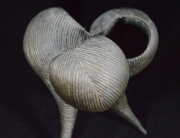[fullwidth backgroundcolor=”” backgroundimage=”” backgroundrepeat=”no-repeat” backgroundposition=”left top” backgroundattachment=”scroll” video_webm=”” video_mp4=”” video_ogv=”” video_preview_image=”” overlay_color=”” overlay_opacity=”0.5″ video_mute=”yes” video_loop=”yes” fade=”no” bordersize=”0px” bordercolor=”” borderstyle=”” paddingtop=”20px” paddingbottom=”20px” paddingleft=”0px” paddingright=”0px” menu_anchor=”” equal_height_columns=”no” hundred_percent=”no” class=”” id=””][title size=”1″ content_align=”left” style_type=”” sep_color=”” class=”” id=””][/title][five_sixth last=”yes” spacing=”yes” background_color=”” background_image=”” background_repeat=”no-repeat” background_position=”left top” border_size=”0px” border_color=”” border_style=”” padding=”” class=”” id=””][fusion_text]
Two Muslims
Deepak Shimkhada
Ibrahim Adil Shah II who ruled Bijapur during the 16-17th centuries shares many similarities with Dara Shikoh, the eldest son of the Mughal Emperor Shah Jahan who ruled India in the 17th century. Ibrahim and Dara seem to be moderate Muslims who took interest in native art, cultures and religions who tried to find a balance between their faiths and those of the country they ruled. Writing about Ibrahim Adil Shah II of Bijapur, William Dalrymple writes in his review of the book The Visual World of Muslim India: The Art, Culture and Society of the Deccan in the Early Modern Era edited by edited by Laura E. Parodi, 2015:
“The artists, writers, and craftsmen who worked for Ibrahim were drawn from a wide variety of backgrounds and religions, and crossed the divide both between Sunni and Shia and between Hindu and Muslim. For the officially Muslim but deeply syncretic Ibrahim did share one very important quality with his Mughal contemporary Akbar: his fondness for, and interest in, Hinduism. Early in his reign Ibrahim gave up wearing jewels and adopted instead the rudraksha rosary of the Hindu sadhu. He visited both Shaivite temples and the monasteries of the Nath yogis, and knew Sanskrit better than Persian. According to the art historian Mark Zebrowski:
‘It is hard to label him either a Muslim or a Hindu; rather he had an aesthete’s admiration for the beauty of both cultures.’
Again, Dalrymple writes, “In his songs Ibrahim uses highly Sanskritized language to shower equal praise upon Sarasvati, Hindu goddess of learning, the Prophet Muhammed, and the Sufi saint Gesudaraz of Gulbarga. In his fifty-sixth song this Muslim sultan more or less describes himself as a Hindu God:
He is robed in saffron-coloured dress, his teeth are black, the nails are red…and he loves all. Ibrahim, whose father is god Ganesh and…mother pious Sarasvati, has a rosary of crystal round his neck…and an elephant as his vehicle.
Ibrahim’s preferred Sanskrit title was Jagatguru, “World Teacher.” Bringing together Hindu and Muslim traditions in an atmosphere of heterodox learning, and uniting Persians, Africans, and Europeans in a cosmopolitan artistic meritocracy, Ibrahim presided over a freethinking court in which art was a defining passion. For Ibrahim was literally obsessed with the power of art. In his poems he dwells on its ability to bring people together, and on the way that art, and particularly music, acted on the body and was capable of moving an individual to tears, or ecstasy, or a deep melancholic sadness.
Under his patronage, the court of Bijapur developed a theory of aesthetics that sought to reconcile the old Greek medical ideas of the humors of the body with Hindu ideas about the capacity of music to affect a sensitive person through rasa, or aesthetic appreciation. Developing the idea at the center of Sanskrit aesthetics of the nine rasas—literally “flavors,” “essences,” or “emotions”—nauras became the central theme of Ibrahim’s reign; the word expresses the binding aesthetic force that he hoped would hold the diverse subjects and religions of his empire together.’”
With these thoughts deeply embedded in the native traditions of India, Ibrahim of Bijapur was a model ruler better than any Hindu rulers of the time. Not all Muslims can be classed in the same category as we often do today when we see an event directly or indirectly connected to Islam. An individual, regardless of his faith, must be judged not by his religion but by his action. We should blame the person for his action, not his religion.
[/fusion_text][/five_sixth][/fullwidth]









Leave A Comment